A Sicilian disaster - A Scotisch gambit victory
Last Game N°5 Round 1
After my feable play of the last Game, this one keeps you smiling
Montse (1565) - Samy,H (1513) [B30], 30.01.2007
1.e4 c5 2.Nf3 Nc6 3.Bc4 d6 4.d4 cxd4 5.Nxd4 Ne5?!

I do not understand why they always attack immediately. The sensible move Nf6 or Qb6 might be much better. Anyway the knight on e5 can easily be pushed away from its central square by white by playing f4-f5. But before you play this it is better to get your pieces coordinated to support the attack. So the general maxim "develop before you start attacking your opponent" is still valid.
6.Be2 Bd7 7.Nc3 e6 8.Be3 a6 9.0-0 Be7
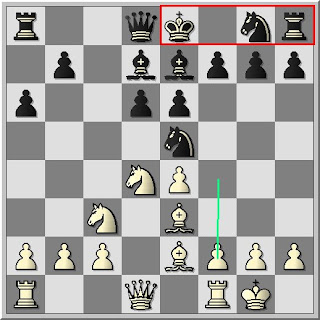
White retreats the bishop to e2 to guard against g4 & c4 tricks. Your light squared bishop is currently too valuable to be traded. White keeps on developing pieces into the game. Be3 is necessary because when white push the f-pawn, your g1-a7 diagonal becomes very weak. Therefore you protect it with the dark squared bishop. Although at first sight white's position seems a little bit passive, it is full of potential energy ready to be unleached.
If we compare after 9 moves both positions we see that black still holds a knight on g8. It is time to use this fact by launching an attack to his undeveloped kingside. What a better move than f4 do we have? Notice that Black is currently lagging two moves behind white to complete his development (Knight development and castling)
10.f4 Nc6 11.Nxc6 Bxc6 12.f5
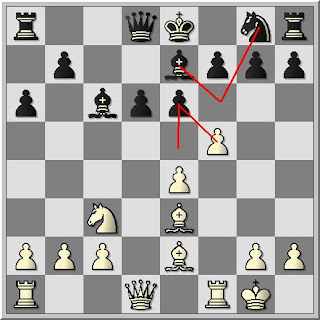
Before you play f5 you need to know what positions might rise from this move.
1. Capture exf5
2. Other moves such as developing moves Nf6, Bf6, e5
3. Currently there are no immediate threats against the king position
I got Mr Brainless working on how to solve this:
A)12...exf5 13.Bc4 f6 14.Rxf5 0-0 15.Bd4! Bd7 16.Rf4 Rc8 17.Qd3 (diagram)±
playing for black's d-pawn seems interesting
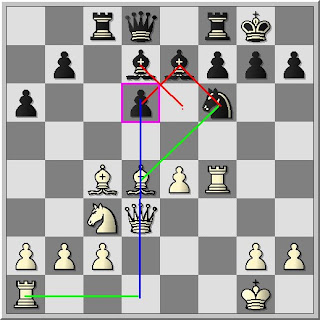
B)12...exf5 13.Rxf5 (best) Nf6 14.Qd3 0-0 15.Bd4 Bd7 16.Rf2 Be6 17.Raf1 Rc8 (diagram 1) 18.Nd5 Nxd5 19.exd5 Bxd5 20.Bxg7 Kxg7 21.Qxd5 Qb6 22.Bd3 (diagram 2)+/-


My ideas are simple. For instance White will pressurize along the f-file, especially to the square f7 and try to weaken at the same time black's kingside.
12.f5 Nf6 13.fxe6 fxe6 14.Bh5+ Nxh5? 15.Qxh5+ g6 16.Qf3 Rf8 17.Qh3+-
So Nxh5 is not playable (remove the attacker), A possible move left is g6 (blocking move). I did not consider the move to put the king out of check as the center pawns are very weak and cannot be really used as pawn shield for your king.
12.f5 Nf6 13.fxe6 fxe6 14.Bh5+ g6 15.Be2 0-0 16.Qd3 Qd7 17.Rf3 b5 18.a3 Qb7 19.Bg5 Rf7 20.Raf1 Raf8 += We obtain an interesting position.
The tactic with 19. ... Nxe4 fails
19...Nxe4 20.Bxe7! Rxf3 21.gxf3 Nxc3 22.Qxc3 and white's Bishop on e7 is indirectly protected by the white Queen as the black Queen is tied down to the protection of its bishop on c6.
If white had responded with 19...Nxe4 20.Nxe4? Bxe4 21.Rxf8+ Rxf8 22.Qg3 Bxg5 23.Qxg5 Qb6+ and black has an great position -+
threat is a Q-invasion on f2 and causing a double attack with mate pressure on g1 and capture of the bishop. So Qg4 seems to be only reply but what will white do on Rf4. White's only chance lies in a perpetual check on the black king as he is quite exposed.
So let's go back to the game
12.f5 Bf6 13.fxe6 fxe6 14.Bd3
Now Bd3 has a double edge. If he miss the threat involved he is about to go down in a spectacular fashion. If he answers correctly he is able to equalize.
My first idea was to put the bishop on c4. But this was too my idea not a real threat. It belongs more to the category getting small advantages. So then I was looking at Bd3. At first it seems very passive.

Also black is still undeveloped so if he wants to castle short his N will go to e7 and then probably to g6. I used that idea to set up an attack. I can force him to play Ng6 if I play Qh5. He can answer with g6 but this will structurally speaking be a weakening to his kingside as the Q can go to h6 or I have other possibilities. I have the forcing move e5 which unveils my bishop with attack on his bishop. So I have to be aware that If I play Bd3 he might answer with e5, blocking the pawn push to e5 and protecting the dark squared bishop. So Can 14.Bd3 be met with 14....e5?
Without calculation you can easily see that his light squared fields will become extremely vulnerable around the king. White can take easily control over these fields by playing Bc4. Besides that black has given himself a backward pawn in the center and the king is still in the center. This backward pawn is not supported by any other pawn which makes it extremely vulnerable.
So 14...e5? 15.Qh5+ g6 16.Qf3 b5 Necessary to prevent Bc4, otherwise white will kill off the knight and with this win Bf6 17.a4!! +- This is much better than playing directly 17. Nd5.
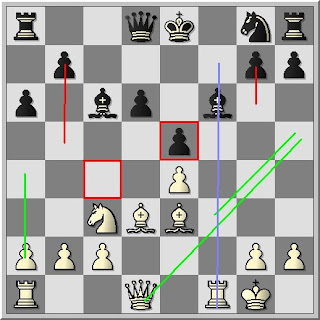
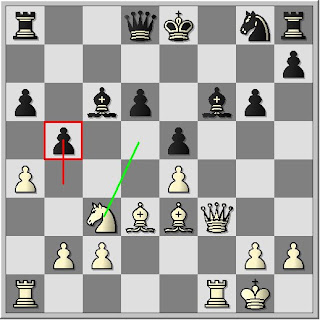
So everything seems to be OK. Now the "seems" should be stressed. I missed 14... Bxc3. UUh. My brainless interface pointed out to me that I was lucky and played a bad move with 14Bd3. At first I resented the idea. I looked a little bit closer and try to understand why this move would equalize.
- the exchange forces a structural weakness to the endgame.
- with this exchange a potential attacker has been removed. White was waiting to activate his knight towards d5, e4.
- Main reason: the exchange lead to a gain in tempo for black to develop his knight as white is stalled for one move in his play. He is being forced to recapture to equalize. The field on f6 has been vacated for his knight. So black can develop the knight to f6 and protect his king at the same time against Qh5 check. The e5 pawn push is not possible anymore as there is not immediately anything to gain at the kingside. In other words white has lost the initiative.
14...Bxc3!! 15.bxc3 Nf6 16.Bg5 =

I believe that 14...Bxc3 is not such an obvious move to spot as tendency goes that you want to keep the bishop pair intact. Exchanging must give you a feel that this position would be equalizing otherwise you don't play this move even if you have considered it.
Well, what do you expect.
14.Bd3? Ne7 15.Qh5+ Ng6 (diagram) 16.e5 dxe5 17.Bxg6+ Ke7 18.Bc5+ Kd7 19.Rad1+ Bd5 20.Nxd5 Kc6 21.Nb4+ 1-0
we have the typical connection 1-2-3 (red squares)

1 knight
2 pawn
3 rook
The knight is being tagged by the bishop (green dots) and the rook by the queen (purple dots).

My opponent played as I imagined. As shown in the diagram I exploited this weakness of my opponent. So again a good development plan is important.
15...g6 is not a solution neither.
15...g6 16.Qh3 should learn to play this position! 16...Bxc3 17.bxc3 Qd7 18.Qh4 0-0-0 19.Rf7 Rde8 (20.Raf1!)
16.Qf3 would not be considered as good as Black answers with Nf5!!. Pawn is pinned against my Q. So pawn on e4 cannot guard f5. It is important to keep the activity of your pawns and pieces maximal.
20. Bg5 fails due to
20.Bg5? h6 21.Bxe7 g5 and the Queen can no longer protect the bishop.
Final position before he resigned.

Well, this makes 4,5 out of 5 games. Let's keep it that way.
After my feable play of the last Game, this one keeps you smiling
Montse (1565) - Samy,H (1513) [B30], 30.01.2007
1.e4 c5 2.Nf3 Nc6 3.Bc4 d6 4.d4 cxd4 5.Nxd4 Ne5?!

I do not understand why they always attack immediately. The sensible move Nf6 or Qb6 might be much better. Anyway the knight on e5 can easily be pushed away from its central square by white by playing f4-f5. But before you play this it is better to get your pieces coordinated to support the attack. So the general maxim "develop before you start attacking your opponent" is still valid.
6.Be2 Bd7 7.Nc3 e6 8.Be3 a6 9.0-0 Be7

White retreats the bishop to e2 to guard against g4 & c4 tricks. Your light squared bishop is currently too valuable to be traded. White keeps on developing pieces into the game. Be3 is necessary because when white push the f-pawn, your g1-a7 diagonal becomes very weak. Therefore you protect it with the dark squared bishop. Although at first sight white's position seems a little bit passive, it is full of potential energy ready to be unleached.
If we compare after 9 moves both positions we see that black still holds a knight on g8. It is time to use this fact by launching an attack to his undeveloped kingside. What a better move than f4 do we have? Notice that Black is currently lagging two moves behind white to complete his development (Knight development and castling)
10.f4 Nc6 11.Nxc6 Bxc6 12.f5

Before you play f5 you need to know what positions might rise from this move.
1. Capture exf5
2. Other moves such as developing moves Nf6, Bf6, e5
3. Currently there are no immediate threats against the king position
I got Mr Brainless working on how to solve this:
A)12...exf5 13.Bc4 f6 14.Rxf5 0-0 15.Bd4! Bd7 16.Rf4 Rc8 17.Qd3 (diagram)±
playing for black's d-pawn seems interesting

B)12...exf5 13.Rxf5 (best) Nf6 14.Qd3 0-0 15.Bd4 Bd7 16.Rf2 Be6 17.Raf1 Rc8 (diagram 1) 18.Nd5 Nxd5 19.exd5 Bxd5 20.Bxg7 Kxg7 21.Qxd5 Qb6 22.Bd3 (diagram 2)+/-


My ideas are simple. For instance White will pressurize along the f-file, especially to the square f7 and try to weaken at the same time black's kingside.
12.f5 Nf6 13.fxe6 fxe6 14.Bh5+ Nxh5? 15.Qxh5+ g6 16.Qf3 Rf8 17.Qh3+-
So Nxh5 is not playable (remove the attacker), A possible move left is g6 (blocking move). I did not consider the move to put the king out of check as the center pawns are very weak and cannot be really used as pawn shield for your king.
12.f5 Nf6 13.fxe6 fxe6 14.Bh5+ g6 15.Be2 0-0 16.Qd3 Qd7 17.Rf3 b5 18.a3 Qb7 19.Bg5 Rf7 20.Raf1 Raf8 += We obtain an interesting position.
The tactic with 19. ... Nxe4 fails
19...Nxe4 20.Bxe7! Rxf3 21.gxf3 Nxc3 22.Qxc3 and white's Bishop on e7 is indirectly protected by the white Queen as the black Queen is tied down to the protection of its bishop on c6.
If white had responded with 19...Nxe4 20.Nxe4? Bxe4 21.Rxf8+ Rxf8 22.Qg3 Bxg5 23.Qxg5 Qb6+ and black has an great position -+
threat is a Q-invasion on f2 and causing a double attack with mate pressure on g1 and capture of the bishop. So Qg4 seems to be only reply but what will white do on Rf4. White's only chance lies in a perpetual check on the black king as he is quite exposed.
So let's go back to the game
12.f5 Bf6 13.fxe6 fxe6 14.Bd3
Now Bd3 has a double edge. If he miss the threat involved he is about to go down in a spectacular fashion. If he answers correctly he is able to equalize.
My first idea was to put the bishop on c4. But this was too my idea not a real threat. It belongs more to the category getting small advantages. So then I was looking at Bd3. At first it seems very passive.

Also black is still undeveloped so if he wants to castle short his N will go to e7 and then probably to g6. I used that idea to set up an attack. I can force him to play Ng6 if I play Qh5. He can answer with g6 but this will structurally speaking be a weakening to his kingside as the Q can go to h6 or I have other possibilities. I have the forcing move e5 which unveils my bishop with attack on his bishop. So I have to be aware that If I play Bd3 he might answer with e5, blocking the pawn push to e5 and protecting the dark squared bishop. So Can 14.Bd3 be met with 14....e5?
Without calculation you can easily see that his light squared fields will become extremely vulnerable around the king. White can take easily control over these fields by playing Bc4. Besides that black has given himself a backward pawn in the center and the king is still in the center. This backward pawn is not supported by any other pawn which makes it extremely vulnerable.
So 14...e5? 15.Qh5+ g6 16.Qf3 b5 Necessary to prevent Bc4, otherwise white will kill off the knight and with this win Bf6 17.a4!! +- This is much better than playing directly 17. Nd5.


So everything seems to be OK. Now the "seems" should be stressed. I missed 14... Bxc3. UUh. My brainless interface pointed out to me that I was lucky and played a bad move with 14Bd3. At first I resented the idea. I looked a little bit closer and try to understand why this move would equalize.
- the exchange forces a structural weakness to the endgame.
- with this exchange a potential attacker has been removed. White was waiting to activate his knight towards d5, e4.
- Main reason: the exchange lead to a gain in tempo for black to develop his knight as white is stalled for one move in his play. He is being forced to recapture to equalize. The field on f6 has been vacated for his knight. So black can develop the knight to f6 and protect his king at the same time against Qh5 check. The e5 pawn push is not possible anymore as there is not immediately anything to gain at the kingside. In other words white has lost the initiative.
14...Bxc3!! 15.bxc3 Nf6 16.Bg5 =

I believe that 14...Bxc3 is not such an obvious move to spot as tendency goes that you want to keep the bishop pair intact. Exchanging must give you a feel that this position would be equalizing otherwise you don't play this move even if you have considered it.
Well, what do you expect.
14.Bd3? Ne7 15.Qh5+ Ng6 (diagram) 16.e5 dxe5 17.Bxg6+ Ke7 18.Bc5+ Kd7 19.Rad1+ Bd5 20.Nxd5 Kc6 21.Nb4+ 1-0
we have the typical connection 1-2-3 (red squares)

1 knight
2 pawn
3 rook
The knight is being tagged by the bishop (green dots) and the rook by the queen (purple dots).

My opponent played as I imagined. As shown in the diagram I exploited this weakness of my opponent. So again a good development plan is important.
15...g6 is not a solution neither.
15...g6 16.Qh3 should learn to play this position! 16...Bxc3 17.bxc3 Qd7 18.Qh4 0-0-0 19.Rf7 Rde8 (20.Raf1!)
16.Qf3 would not be considered as good as Black answers with Nf5!!. Pawn is pinned against my Q. So pawn on e4 cannot guard f5. It is important to keep the activity of your pawns and pieces maximal.
20. Bg5 fails due to
20.Bg5? h6 21.Bxe7 g5 and the Queen can no longer protect the bishop.
Final position before he resigned.

Well, this makes 4,5 out of 5 games. Let's keep it that way.


0 Comments:
Post a Comment
<< Home